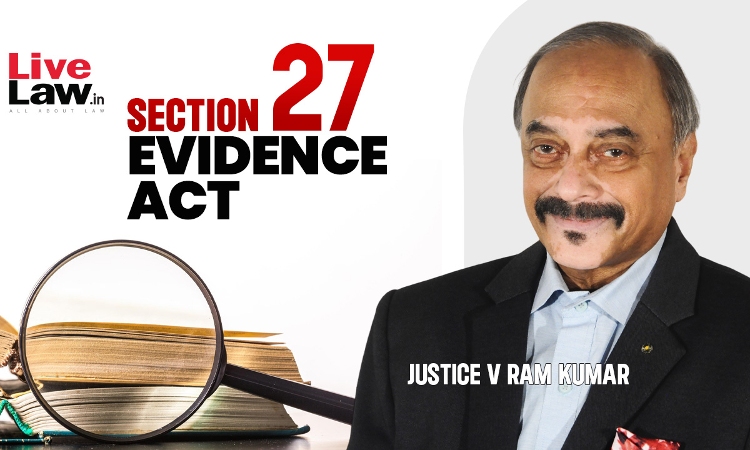'What Is The Main Purpose Of Section 27 Of The Evidence Act? '
Justice V. Ramkumar
19 Aug 2024 8:08 PM IST
There is a popular misconception that the purpose of Section 27 of the Indian Evidence Act, 1872, is to lift the ban on “confession” made to a Police Officer as imposed by Sections 25 and 26 of the Evidence Act. It is not so. The essential purpose of Section 27 of the Evidence Act is not to render admissible a “confession” in the “disclosure statement” made by an accused to a...
There is a popular misconception that the purpose of Section 27 of the Indian Evidence Act, 1872, is to lift the ban on “confession” made to a Police Officer as imposed by Sections 25 and 26 of the Evidence Act. It is not so. The essential purpose of Section 27 of the Evidence Act is not to render admissible a “confession” in the “disclosure statement” made by an accused to a Police Officer. Cases in which a “confession” in the “disclosure statement” becomes admissible under Section 27 of the Evidence Act are only very few and far between. In the majority of cases, the “information” received by a Police Officer under Section 27 is a “disclosure statement” regarding the “place” of concealment of the incriminating object and the “exclusive knowledge of the accused” regarding that place. If in such a “disclosure statement” there is a “confession” by the accused, then, as per the interpretation given to Section 27 in the celebrated Pulukuri Kottaya v. Emperor AIR 1947 P C 67 – Sir John Beaumont – J, such a “confession” is inadmissible in evidence and is to be excluded.
For example, an accused while in custody of a Police Officer gives the following “information”—
“I have hidden the knife with which I stabbed Govind in the bathroom at the first floor of my house.”
Here, the highlighted portion namely, “with which I stabbed Govind” is inadmissible in evidence and is liable to be excluded. If the confessional or inculpatory part of the “disclosure statement” is so excluded, then what remains is only a mere statement (not a confession) made to a Police Officer which will, however, be hit by the ban under Section 162 (1) Cr.P.C. It is to lift the above ban under Section 162 (1) Cr.P.C. that sub-section (2) of Section 162 Cr.P.C. provides that the interdict under Section 162 (1) Cr.P.C. will not apply to a “statement” admissible under Section 27 of the Evidence Act. If a “disclosure statement” under Section 27 of the Evidence Act should not contain a “confession” in view of the interpretation in Pulukuri Kottaya (Supra – AIR 1947 PC 67), then a question may legitimately arise as to why Section 27 uses the words “whether it amounts to a confession or not”. This aspect of the matter has also been answered by Pulukuri Kottaya in a couple of sentences occurring in paragraph 11 of the AIR citation which reads as follows :-
“The difficulty, however great, of proving that a fact discovered on information supplied by the accused is a relevant fact can afford no justification for reading into Section 27 something which is not there and admitting in evidence a confession barred by Section 26. Except in cases in which the possession or concealment of an object constitutes the gist of the offence charged, it can seldom happen that information relating to the discovery of a fact forms the foundation of the prosecution case. It is only one link in the chain of proof and the other links must be forged in the manner allowed by law.”
What the above passage means is that a “disclosure statement” after excluding the confessional part of the statement, does not constitute the gist of the offence but is only a link in the chain of proof. Since the “disclosure statement” is only a corroborative piece of evidence, other links such as prior user of the object for the commission of the offence etc, will have to be proved by direct or circumstantial evidence. But, if the “possession” or “concealment” of the incriminating object itself constitutes the gist of the offence (as in the case of Opium Act, 1978, Drugs and Cosmetics Act, 1940, Explosives Act, 1884, Explosive Substances Act, 1908, Public Gambling Act, 1867, Gold Control Act, 1968, Narcotic Drugs Act and Psychotropic Substances Act, 1985,) then the whole of the “disclosure statement” would be admissible notwithstanding the fact that the statement amounts to a “confession”. In such cases, the statement including the confessional part which is an inseparable part of the statement, would be admissible in its entirety and it can constitute “substantive evidence”. It is only in these few categories of cases do the words “whether it amounts to a confession or not” occurring in Section 27 of the Evidence Act, have any application. In the majority of cases the “disclosure statement” only reveals the place of concealment of the object and exclusive knowledge of the accused about that place. In those majority of cases, there is no “confession” involved so as to attract the bar under Sections 25 or 26 of the Evidence Act. But, in the minority of cases, the confessional part of the “disclosure statement” will also be admissible in evidence since “possession” or “concealment” of the object itself constitutes an offence under the penal provision concerned.
In the light of what is stated above, those judicial verdicts which say that a confession made under Section 27 of the Evidence Act will be admissible only if such confession leads to a discovery of fact, are not strictly correct in most of the cases. The purpose of this article is to highlight the above distinction between the two.
Author is Former Judge, High Court of Kerala.
Views Are Personal


